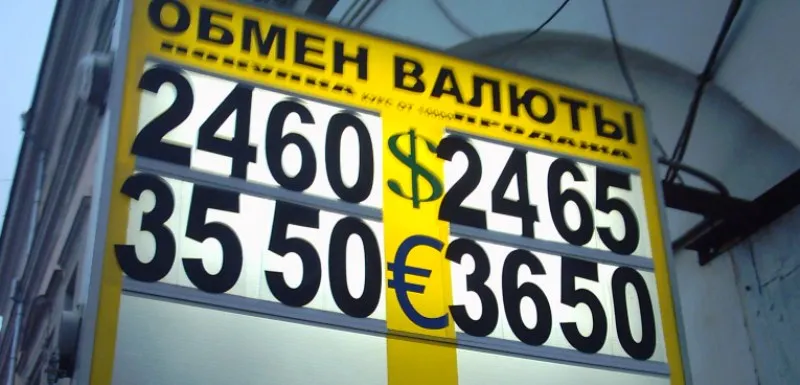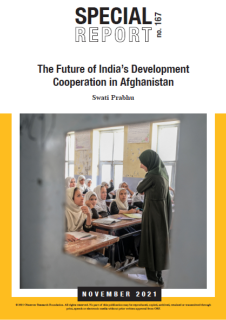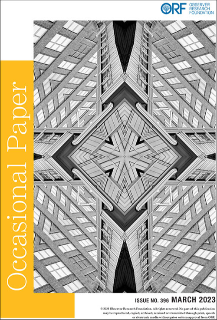As 2014 drew to a close, the recession of Russia’s economy was already evident. Things have only gotten worse since then — with its GDP contracting by 3.7 percent and the value of the ruble falling about 127 percent in 2015, Russia is now in the midst of a severe economic crunch. Various factors like falling oil prices, economic sanctions, and a weak domestic market have contributed to the ongoing downturn. According to World Bank forecasts, the Russian economy is expected to continue to contract in 2016, albeit a little less than last year. Slow yet positive growth is expected from 2017 onward.
At present, Russia is beset by a variety of external and internal challenges. The country’s status as an energy producer, which previously helped it in economic growth, has now emerged as its major challenge. The Russian economy is heavily reliant on energy export with oil and gas comprising
about half of the government’s revenue. Other raw materials, such as metals, also contribute to the country’s exports. Constantly falling energy and commodity prices throughout 2015 have resulted in significant revenue deficit for Russia. Since commodity prices are expected to remain low for some time, this is much more than a temporary setback. The greatest challenge has emerged in the form of a decline in private investment.
The country’s isolation from international markets owing to sectoral financial sanctions has only worsened the impact of falling oil price prices. Heavy military spending on the other hand, has added a further strain on the economy. According to IHS Jane’s Defense Budgets Annual Report, military spending in Russia
rose by 21 percent in 2015. In spite of the budget cuts that have been announced for 2016, the spending on military continues to remain a significant proportion of government spending in Russia. (The country is in the midst of a military rearmament program that was launched in 2010 to modernize its military hardware by 2020). In this respect, the country’s involvement in Ukraine and Syria intensified the pressure on the economy. Though Russia has now withdrawn “the main part of the Russian Aerospace Forces troops” from Syria,
according to the Kremlin, the deadline for the completion of the withdrawal remains unclear. Moreover forces would continue to remain at a seaport and airbase in Syria’s Latakia province.
However, it is the policy uncertainty within Russia that raises the largest questions over its short-term growth. Russia’s 2016 budget was made in October last year on the assumption of $50 a barrel prices for oil. The current prices stand at less than $30 per barrel, which means that the government has no other alternative but to make cuts. In fact, the Central Bank of Russia has not ruled out a
tightening of its monetary policy in future, should inflation risks amplify. The devaluation of the ruble has increased inflation and reduced real incomes. In 2015, the estimated number of Russians living below the subsistence poverty line was calculated to be 20 million — a sharp increase of 2 million since 2014. Countersanctions imposed by Russia meant that the prices of goods rose faster, leading to a further decrease in consumer demand. With inflation to continue in 2016, a further decline in real wages and real incomes is imminent.
The Transatlantic Trade and Investment Partnership (TTIP) is also a matter of concern for Russia. The TTIP is bound to impact the energy market, which works against Russia. European stakeholders have long been interested in accessing the U.S. crude oil and natural gas. If the United States is able to supply these resources, it would reduce Europe’s dependence on energy imports from Russia. There is also much hope linked with shale gas as it would reduce (at least temporarily) European dependence on hydrocarbon imports. Given the current confrontation between the West and Moscow, the strengthening of economic ties between the US and the EU also has geopolitical implications for Russia. An economically energized Atlantic community with a shared free trade zone
is far more likely to stand firm against Russian pressure.
A model of economic growth dependent on oil exports has thus proved detrimental for the country. As the Russian Prime Minister Dmitri Medvedev himself
has noted, “The current situation on the global oil market shows how the modern structure of the economy is necessary
sustainable economic growth with an emphasis not on the market of raw materials.”
Apart from the economic challenges discussed above, there is a far more serious (yet underestimated) challenge in the form of demographic decline for Russia’s growth in the long term. The country’s population of 143 million has seen minimal growth in the past decade. Till now, the loss of declining population was more than compensated for by the migrant workforce that came to Russia in search of work. The fall in real wages has raised serious question marks on the continuity of this trend. The aging population in Russia means that more households are dependent on transfers from the government in the form of social benefits, pensions, etc. Thus, the budget uncertainty for the coming months has created a lot of ambiguity for the households as it is difficult for them to make informed consumption. The fall in real incomes has exposed Russians to further vulnerabilities.
Opportunities
Some Western analysts also recognise that the Russian economy has managed to adapt to some of the external conditions. According to Kenneth Rapoza, “Enough time has passed for Russia’s economy to learn to balance in the conditions of sanctions.”
In fact, the current slowdown has been a booster for non-oil exports like wheat. Since the Russian ruble is falling in value against the dollar, it implies that the exchange rate is falling. Thus, a weaker ruble has made wheat purchases from Russia more lucrative for other countries. As a matter of fact, while Russian industry witnessed an approximate decline of 3.3 percent decline last year, the country experienced 3 percent growth in agriculture. According to US Department of Agriculture (USDA) statistics, wheat exports from Russia are set to rise to 23.5 million metric tons, outpacing both the United States and Canada.
Meanwhile, the increase in defense investments may in some sense be a boon to Russia’s economy. A report released by Moscow’s Higher School of Economics in late September showed that a rise in military and related defence expenditures, such as “the production of ships, airplanes, spacecraft and other means of transportation,” was one of the primary driving forces behind a surge in industrial production. But the report cautioned that these developments mask stagnation across most other areas of manufacturing.
Future scenarios
Since President Vladimir Putin is most likely to contest the presidential election in March 2018, it is crucial for him to create some semblance of stability. The good news for him is that although the Russian economy is in trouble, a full-blown collapse is unlikely. While many analysts have compared the current situation with the 1998 economic collapse in Russia, the present situation is different because unlike the late 1990s, its public debt is lower (less than 20 percent of the GDP). However; this is not to say that it is going to be a smooth sailing for Russia. The current slowdown is different from the past, when high oil prices more than compensated for Russia’s domestic downturn.
While the current situation holds no imminent threat, the coming three to four years are going to be crucial. It must be reiterated that the fundamental problem for the Russian economy is neither economic sanctions nor falling energy prices but the model of its economic development. A minimum annual growth of about 4 percent in GDP is needed annually for the next five to seven years. To attain this, the government will have to come up with an astute budgetary policy which does not depend on oil prices. Implementation of structural reforms, as the chief executive of Russia’s Sberbank German Gref has remarked, is thus very crucial.
Russia needs to think of alternates for growth by diversifying and innovating itself instead of relying solely on natural resources. Positive growth has already taken place in the agricultural sector. Further initiatives in this sector could be undertaken to reduce dependence on the energy-led economic model. For instance, there is huge potential for Russia to venture into exports of organic foods. Siberia, which is traditionally known for vast deposits of mineral resources, has a congenial ecology for growing organic food products, which Russia could use to its advantage.
To conclude, Russia’s path to recovery and growth depends on the pace of reforms, especially in the next two years. Facilitating structural change will be especially critical as Russia strives to cope in the long-term with a simultaneous demographic and economic transformation. Reforms would require privatization of selected sectors (like textiles), transparent and efficient public investment, better customs administration, and reduced trade barriers to increase the performance of domestic market. However, since the reforms are going to be politically risky, it seems unlikely that Putin will be willing to launch them before the end of his current term in office.
This commentary originally appeared in The Diplomat.
The views expressed above belong to the author(s). ORF research and analyses now available on Telegram! Click here to access our curated content — blogs, longforms and interviews.




 PREV
PREV


